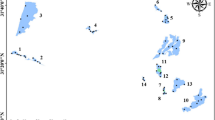Abstract
Leaf litter is a major basal resource to stream ecosystems, but few studies addressed their role in karst systems, mainly in intermittent springs and lakes. Patterns of resource use in perennial rivers are poorly known, although the input of leaf litter strongly influences macroinvertebrate assemblage structure. In this study, we evaluated the structure of macroinvertebrate assemblages along the decomposition of leaf litter in a tropical karst river, using leaf litter cages made of coarse nylon mesh (25 mm) to allow colonization by macroinvertebrates. The experiment was followed weekly for 10 weeks. The assemblages were dominated by snails (90.5% of total fauna), hyalellid amphipods, and larval chironomid midges, with highest abundances in the intermediate stages of the experiment, resulting in a gradient in assemblage structure. The large abundance of snails, which are common in other karst systems, suggest that this group may have an important role in decomposer food webs, facilitating or directly contributing to leaf breakdown.
Similar content being viewed by others
References
Barquin J. and Death R. G. (2004). Patterns of invertebrate diversity in streams and freshwater springs in Northern Spain. Archiv fur Hydrobiologie 161: 329–349
Benstead J. P. (1996). Macroinvertebrates and the processing of leaf litter in a tropical stream. Biotropica 28: 367–375
Casas J. J. and Gessner M. O. (1999). Leaf litter breakdown in a Mediterranean stream characterised by travertine precipitation. Freshwater Biology 41: 781–793
Chergui H. and Pattée E. (1991). An experimental study of the breakdown of submerged leaves by hyphomycetes and invertebrates in Morocco. Freshwater Biology 26: 97–110
Clarke K. R. (1993). Non-parametric multivariate analysis of changes in community structure. Australian Journal of Ecology 18: 117–143
Cummins K. W., Merritt R. W. and Andrade P. C. N. (2005). The use of invertebrate functional groups to characterize ecosystem attributes in selected streams and rivers in south Brazil. Studies on Neotropical Fauna and Environment 40: 69–89
Dias J. (2000). A região cárstica de Bonito, MS: uma proposta de zoneamento geoecológico a partir de unidades de paisagem. Ensaios e Ciência 4: 9–43
Dillon R. (2000). The Ecology of Freshwater Molluscs. Cambrige University Press, Cambridge
Dudgeon D. and Yipp M. (1985). The diets of Hong Kong freshwater gastropods. In: Morton, B. and Dudgeon, D. (eds) Proceedings of Second International Workshop on the Malacofauna of Hong Kong and Southern China, pp 491–509. Hong Kong University Press, Hong Kong
Estebenet A. L. (1995). Food and feeding in Pomacea canaliculata (Gastropoda: Ampullariidae). Veliger 38: 277–283
Gessner M. O. and Dobson M. (1993). Colonisation of fresh and dried leaf litter by lotic macroinvertebrates. Archiv fur Hydrobiologie 127: 141–149
Gessner M. O., Chauvet E. and Dobson M. (1999). A perspective on leaf litter breakdown in streams. Oikos 85: 377–384
Habdija I., Lajtner J. and Belinic I. (1995). The contribution of gastropod biomass in macrobenthic communities of a karstic river. Internationale Revue der Gesamten Hydrobiologie 80: 103–110
Hanlon R. (1981). The influence of different species of leaf litter on the growth and food preference of the prosobranch mollusk Potamopyrgus jenkinsi. Archiv fur Hydrobiologie 91: 463–474
Heard S. B. and Buchanan C. K. (2004). Grazer-collector facilitation hypothesis supported by laboratory but not field experiments. Canadian Journal of Fisheries and Aquatic Sciences 61: 887–897
Heller J. and Abotbol A. (1997). Litter shredding in a desert oasis by the snail Melanopsis praemorsa. Hydrobiologia 344: 65–73
Wallace B. (2002). Ecosystem linkages between southern Appalachian headwater streams and their banks: leaf litter breakdown and invertebrate assemblages. Ecosystems 5: 80–91
Kelley R. H. and Jack J. D. (2002). Leaf litter decomposition in an ephemeral karst lake (Chaney Lake, Kentucky, U.S.A.). Hydrobiologia 482: 41–47
Magurran A. E. (1988). Ecological Diversity and its Measurement. Princeton University Press, Princeton
Ribas, A. C. A., M. O. Tanaka & A. L. T. Souza. An evaluation of macrofaunal effects on leaf litter breakdown rates in aquatic and terrestrial habitats: a case study in the tropics. Austral Ecology (in press)
Rosemond A. D., Pringle C. M. and Ramírez A. (1998). Macroconsumer effects on insect detritivores and detritus processing in a tropical stream. Freshwater Biology 39: 515–523
Rowe J. M., Meegan S. K., Engstrom E. S., Perry S. A. and William B. P. (1996). Comparison of leaf processing under different temperature regimes in three headwaters streams. Freshwater Biology 36: 277–288
Smith H., Wood P. J. and Gunn J. (2003). The influence of habitat structure and flow permanence on invertebrate communities in karst spring systems. Hydrobiologia 510: 53–66
Stockley R. A., Oxford G. S. and Ormond R. F. G. (1998). Do invertebrates matter? Detrital processing in the River Swale-Ouse. The Science of the Total Environment 210/211: 427–435
Vannote R. L., Minshall G. W., Cummins K. W., Sedell J. R. and Cushing C. E. (1980). The river continuum concept. Canadian Journal of Fisheries and Aquatic Sciences 37: 130–137
Vivas S. and Casas J. J. (2002). Macroinvertebrates rates colonizing leaf litter of contrasting quality in a travertine Mediterranean stream. Archive fur Hydrobiologie 154: 225–238
Wallace J. B., Eggert S. L., Meyer J. L. and Webster J. R. (1997). Multiple trophic levels of a forest stream linked to terrestrial litter inputs. Science 277: 102–104
Webster J. R. and Benfield E. F. (1986). Vascular plant breakdown in freshwater ecosystems. Annual Review of Ecology and Systematics 17: 567–594
Whiles M. R. and Wallace J. B. (1997). Leaf litter decomposition and macroinvertebrate communities in headwater streams draining pine and hardwood catchments. Hydrobiologia 353: 107–119
Author information
Authors and Affiliations
Corresponding author
Electronic supplementary material
Rights and permissions
About this article
Cite this article
Tanaka, M.O., Ribas, A.C.A. & de Souza, A.L.T. Macroinvertebrate succession during leaf litter breakdown in a perennial karstic river in Western Brazil. Hydrobiologia 568, 493–498 (2006). https://doi.org/10.1007/s10750-006-0195-z
Received:
Revised:
Accepted:
Published:
Issue Date:
DOI: https://doi.org/10.1007/s10750-006-0195-z




